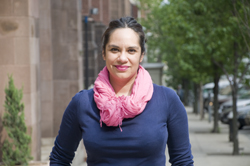Filed Under > Convocation
Helping Mexico's Lost Generations
Mexican immigrant teens are often trapped in dead-end jobs without hope for education. Doctoral graduate Isabel Martinez has explored ways to help
While studying for her doctoral degree in Sociology and Education, Isabel Martinez took a class called “ Sociology and the Life Course,” with Professor Aaron Pallas, which explored how, when, and in what order people assume key social roles, such as becoming an adult or moving from the workforce to retirement.
It was a great class, but it struck Martinez – who is the first member of her family to graduate college, and whose grandmother arrived in the United States from Mexico at age 13, already married – that the life trajectory it described was that of Americans and westerners who graduate from high school and leave home at 18 or 20 to go to college or work. The immigrant teens from Mexico whom Martinez had observed in New York City, riding the subway late at night or working in cafes or restaurants around Columbia University were living an entirely different sort of life. Those youngsters had typically graduated or dropped out of the equivalent of junior high school in Mexico and left their homes at ages as young as 14 – many unescorted by an adult – to work at low-paying jobs and send money back home. Most intend to return to Mexico and their families – even to school – but few do.
“I wasn’t digging this idea of transitions,’ ” Martinez recalled. Mexican immigrant youth, she said, “are experiencing an accelerated life course. They start to work as early as they can be productive. Being fourteen didn’t mean, ‘oh, we’re going to hang out at the mall.’
With all the discussion among U.S. educators and policymakers about how to keep immigrant youth from dropping out, Martinez, motivated by her experience in Pallas’ course, decided to focus on the nation’s 200,000-odd young people who never “drop in” -- those who bypass school altogether and go directly into the workforce, or who go to nontraditional programs designed for adults, such as English-language or GED classes. “Most of the discussions center around schools,” Martinez said, “but this group never has an interaction with the traditional K-12 system.”
More specifically, Martinez decided her dissertation would be a study of teenage Mexican immigrants. With encouragement from Pallas – who, she said, was extraordinarily supportive and helpful – and funding through the Office of the Vice President for Diversity and Community Affairs and the Provost’s Office, Martinez travelled to the Mexican state of Puebla, which sends the largest number of young Mexican immigrants to New York City. She interviewed 18 Mexican teens who were considering or preparing to come to the U.S. Most said they wanted to come and earn a little money by working in restaurants or bodegas, the girls by working as maids or nannies. Their main goal was to send money back home to help support their families, or to save up to continue their own schooling or establish their own businesses in Mexico. Few planned to settle in the U.S. permanently.
But when Martinez returned to New York and interviewed 35 Mexican immigrant youths there, she found a very different reality. Some were stuck in minimum-wage (or lower) jobs, working more than 70 hours a week. They longed to go to school, but couldn’t find bilingual programs that fit their erratic work schedules. And after sending several hundred dollars home each month, most doubted whether they could save enough money to return to Mexico.
Martinez’ dissertation, “Making Transnational Adults from Youth: Mexican Immigrant Youth in Pursuit of the Mexican Dream,” recommends some steps to help young Mexican immigrants get an education, so that they have the choice about whether to stay in the U.S. or go home. American educators and policymakers “need to think a little more creatively” about designing programs that would work better for them, such as offering bilingual or English-language classes, or GED classes in Spanish, at flexible times or online. Mexico needs to do its part, Martinez said, by working with kids who want to leave, to help them explore educational or work opportunities closer to home. More broadly, of course, overall conditions for families need to improve, so that teenagers are less likely to need to leave to support their families. Or, as Martinez puts it: “How could these people’s lives be improved so that they wouldn’t have to leave to survive?”
Now an assistant professor in the Department of Latin American and Latina/o Studies at John Jay College of Criminal Justice in New York, Martinez would like to expand her research to include more teens and adult immigrants, to discover how the United States can discourage employers from hiring them under exploitative conditions, and encourage them to get an education. She and a group of other scholars have secured funding to research the effect of the North American Free Trade Agreement (NAFTA) on the number of young Mexican immigrants to the United States.
Obviously, Martinez has her own family history in mind as she undertakes this work – but that, in her view, is as it should be.
“Education and improving people’s lives is personal,” she says.
Published Friday, May. 27, 2011
